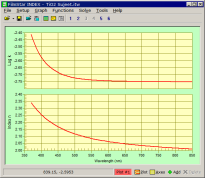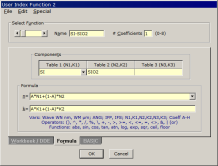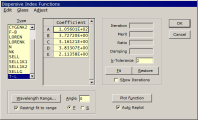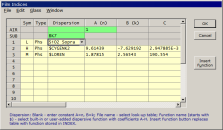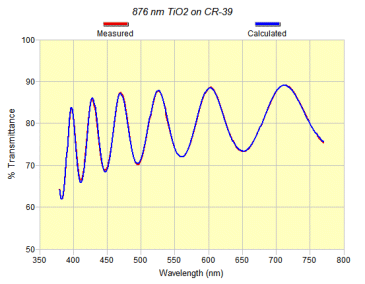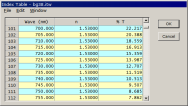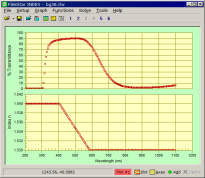The ability to deduce dispersive indices is crucial for the
successful
optical coating |
|||||||||||||||||||||||||||||||||||||||||||||||||||||||||||||||||||
Index ValuesEdit, plot and store tables of n,k vs. wavelength for subsequent use in DESIGN. Built-in index functions (Lorentz, Sellmeier, etc.) can be plotted and fitted to these n,k tables. The extensive Sopra (537K) database of ellipsometrically determined index tables is included. Click here for information about importing n,k data and dispersion functions from other sources. |
|||||||||||||||||||||||||||||||||||||||||||||||||||||||||||||||||||
User-Defined FunctionsIndices (n,k) can be represented by built-in and user-defined
functions. Built-in functions include Buchdahl, Cauchy,
Lorentz, Sellmeier, Forouhi-Bloomer, Tauc-Lorentz, GaAlAs (Afromowitz), etc. Users may add new functions
in a built-in equation editor, in the FilmStar Workbook, in MS Excel,
etc. These functions ultimately appear as if built into INDEX and DESIGN. |
|||||||||||||||||||||||||||||||||||||||||||||||||||||||||||||||||||
|
|
Index-Fitting Algorithms
Spectral data can be obtained with FilmStar MEASURE or with any program that can output ASCII files. Index functions are further refined in DESIGN via inverse synthesis. The goal is to achieve the excellent agreement illustrated below: |
||||||||||||||||||||||||||||||||||||||||||||||||||||||||||||||||||
Filter GlassFilmStar provides convenient handling of absorbing glass
substrates. Transmittance (internal t or measured %T/OD) values are converted
to k values or t/%T/OD for other thicknesses. Multiple filter glass substrates with varying
thickness can be used in a thin film design. Because of differences between melts, careful Related topic: https://ftgsoftware.com/filterglass_nk.htm |
|||||||||||||||||||||||||||||||||||||||||||||||||||||||||||||||||||

